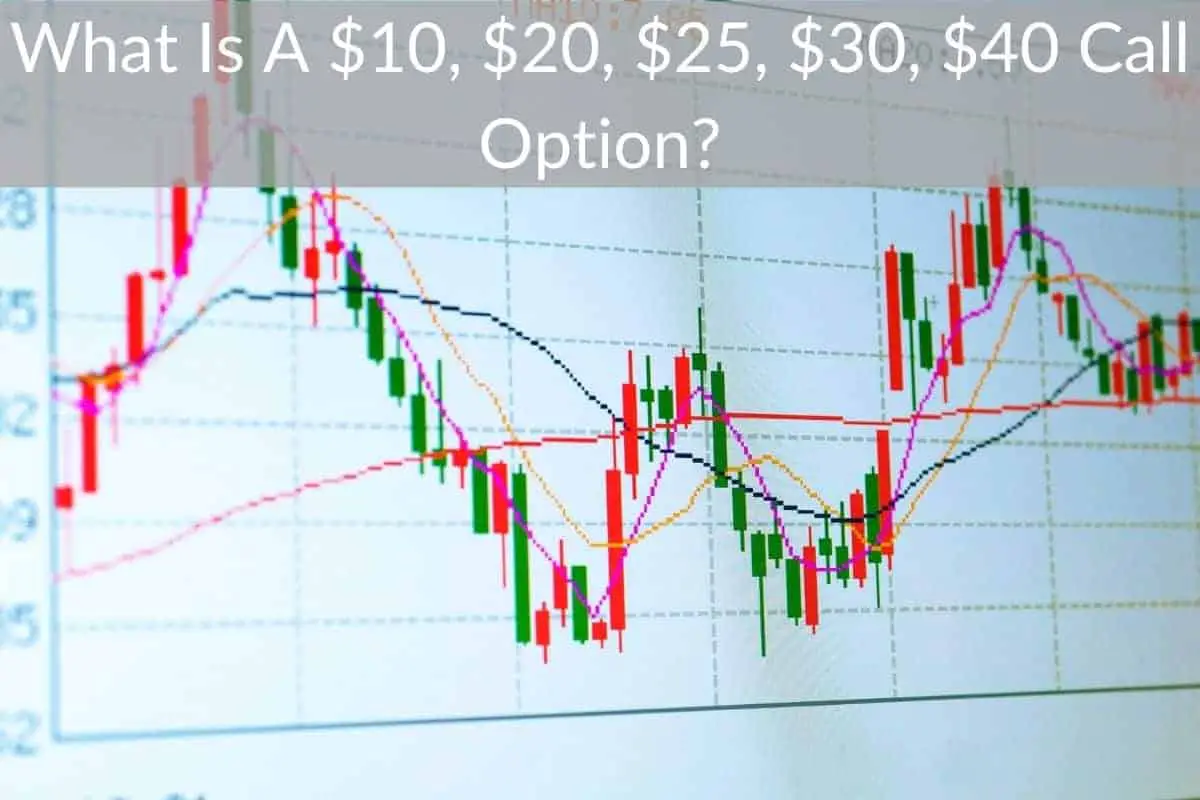Table of Contents
Call options are one of the two main possibilities in the options trading world. A call option buyer believes the price of the underlying will rise within a specific time window.
*This post may contain affiliate links. As an Amazon Associate we earn from qualifying purchases.
But what does a $10, $20, $25, $30, $40 call option mean?
A $10, $20, $25, $30, $40 call option is a type of call option where the buyer expects the price of the underlying asset to rise above those specific strike prices within a specific time frame. In options each dollar amount is considered the “strike price”.
If the asset reaches the strike price, the buyer of the options can exercise their right to buy.
So, a $10 call is simply buying a call option with a $10 strike price. The same is true for a $20, $25, $30, or $40 call. The dollar amount mentioned is the strike price of the specific call.
In the rest of this article I will look at how these options work and all you need to know about them.
Explaining $10, $20, $25, $30, $40 Call Options
The first thing you should know regarding why these call options that have different dollar values is that all options are derivatives. Their movement is dependent on another financial product—known as the underlying asset (in this case the stock).
So, the buyer of a $10 call option expects the underlying asset’s (stock) price to reach a price of $10 or higher before the expiry date.
The specific price ($10, $20, $25, $30, or $40) is the strike price. Once the price is reached, the buyer of a call option has the right to buy the underlying asset at that price no matter how high the price of the stock goes.
Say for example I buy a $10 call in ABC company. I might have to pay .50 for that call option which means I will pay $50 for the contract (all US options are in 100 share contracts). If the stock price of ABC goes to $11 I could exercise my call options and buy the stock for $10 netting me a .50 profit (the $1 stock price difference minus the premium I paid for the call).
However, if the ABC stock skyrockets to $100 a share before the expiration date on the call I can STILL buy those shares for $10 meaning I would now have a $89.50 profit per share (or $8,950) on the call option contract.
$10, $20, $25, $30, or $40 US and European-Style Call Options
$10, $20, $25, $30, or $40 call options are typically written by brokers and sold to traders, but traders can also write and sell them to others.
With a US-style call option, the buyer has the right to buy the underlying asset at any point during the term of the contract. Once the option expires, the contract ends.
For European style call options, buyers also have the right to buy the underlying asset, but they can only exercise the option on the expiration date.
The expiry date for all call options, including $10, $20, $25, $30, or $40 US and European-style call options, may be short-term or long-term.
Buyers will typically wait until the strike price has been breached before choosing to exercise their option or to sell. Once they choose to exercise, the option is assigned, and the call seller or writer has to sell the asset (shares of a stock).
The $10, $20, $25, $30, or $40 Call Option Buyer’s Benefits
As I stated above, a call option buyer has the right to buy the option at the strike price, which may be $10, $20, $25, $30, or $40 in this case.
However, the buyer has to pay a premium for this right. The premium may be up to 30-40% of the total contract value on the most volition stock while less volatile stocks will have a lower premium:
The premium goes to the writer or seller of the call option.
Remember, one contract is worth 100 units of the asset. For a stock, it’s 100 shares of the stock. Therefore, with a $30 call option, the premium can be anywhere from .05 to $8 per share (based on volatility of the stock and other factors.
Some of the factors that determine the premium include:
- The length of the option contract
- The distance between the current market price of the asset and the designated strike price
- The volatility of the stock price
- Any news that is expected to come out about the stock/company.
As soon as the stock price goes above the strike price, the option now has intrinsic value. The buyer can decide to exercise the option and receive shares from the call seller.
In many cases, buyers instead choose to sell the option for a profit. The profit actualized depends on how far above the strike price the asset has moved. A buyer’s profit is unlimited on paper.
The $10, $20, $25, $30, or $40 Call Option Seller’s Benefits
A call option seller’s main benefit is the premium they receive from the buyer. Call options sellers write calls to generate income.
However, the income realizable on a single contract is limited to the premium. Once the strike price is reached, further upward price movements are of no significance to the seller as the seller agrees to sell the call at that strike price.
So if a call seller agrees to sell ABC company at $10 then they will sell a call with a $10 strike price. If the stock moves to $15 the call seller will still be required to sell the stock for the $10 because of the option that they sold.
When To Buy $10, $20, $25, $30, or $40 Call Options
You can buy these call options when they are in the money, at the money, and out of the money. The option is in the money when the underlying asset price has gone above the call strike price.
It’s out of the money when the underlying asset price is still below the strike price. The option is at the money when the underlying asset price is the same as the strike price.
Although you can buy a call option at any of these three stages, you’ll need to pay a larger premium for call options already in the money. Such options cost more to buy because they already have intrinsic value.
What Factors Affect the Price Movement of $10, $20, $25, $30, or $40 Call Options?
Several factors affect the price movement of these call options but supply and demand, in addition to asset-specific factors, play the biggest role overall.
For call options on a stock, an imbalance between the supply and demand of the underlying stock can either make the market reach and push above the strike price or cause it to stay firmly below it.
A high-performing stock will have lots of suitors, forcing the price higher and vice versa for the stocks of an underperforming company.
Similarly, a stock from a company that has recently reported increased revenues or launched a new exciting product will likely appreciate. On the other hand, a stock from a company with some negative news around them will either remain static or fall in value depending on the type of news.
However, it’s important to keep in mind that the price movement is only one-half of the equation in any options contract—including call options. The price also has to move in your intended direction within the contract period.
If you are right about the direction of a stock but the stock doesn’t move until after your option expires then it won’t do you any good.
Final Thoughts
$10, $20, $25, $30, or $40 call options are all similar. They are all call options just with different strike prices. All such options may have the same expiry date, but in most cases, they’ll vary.
Confirm the expiry date of any option before you buy.
If you have a European-style $10, $20, $25, $30, or $40 call option and intend to exercise the option after the strike price is breached, you should pay close attention to the expiry date.
You can only exercise your option at expiry. Failing to do so within the approved window, you’ll lose all rights.

